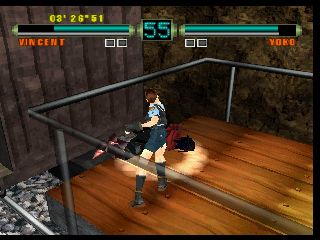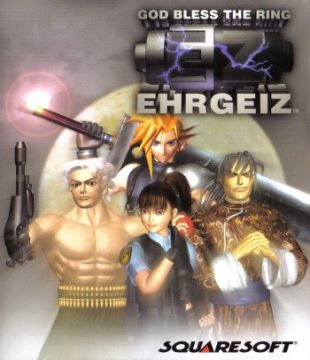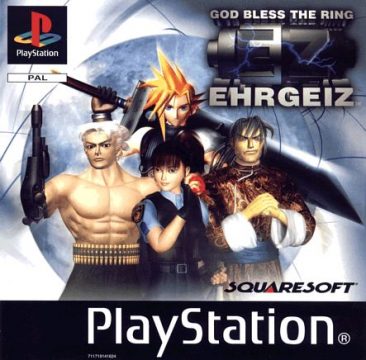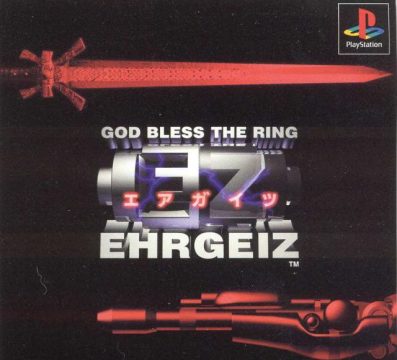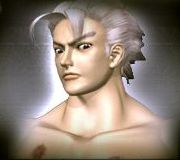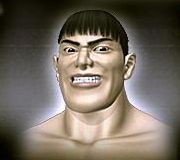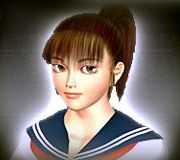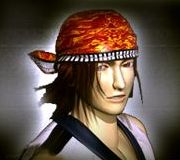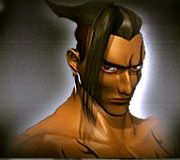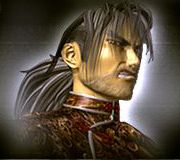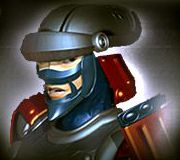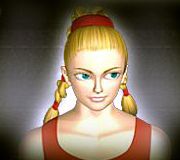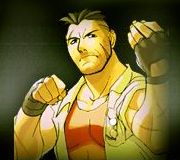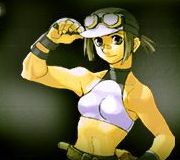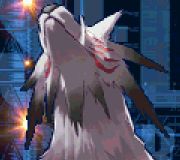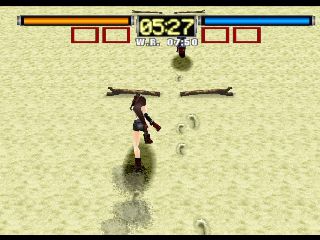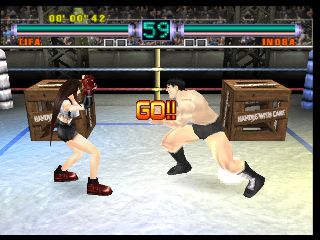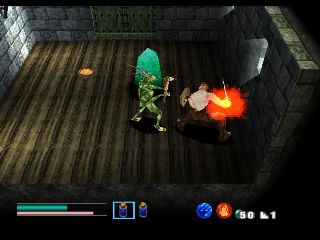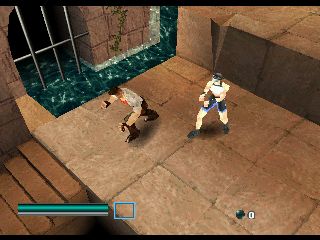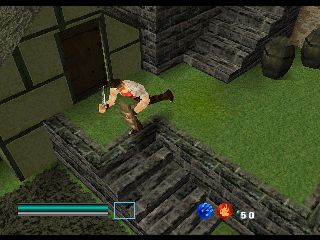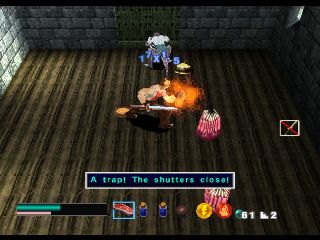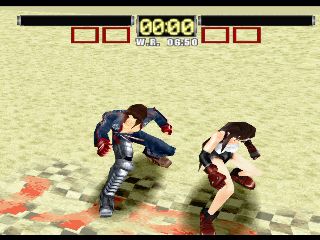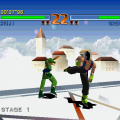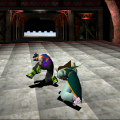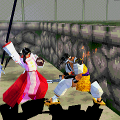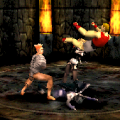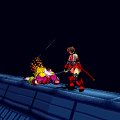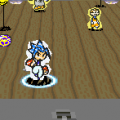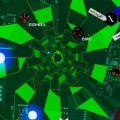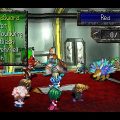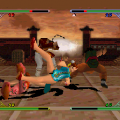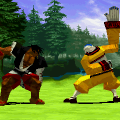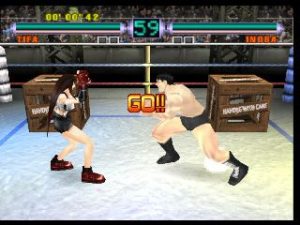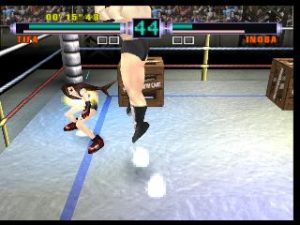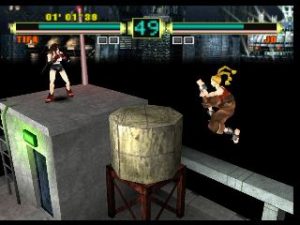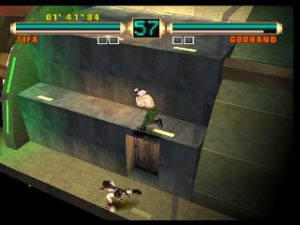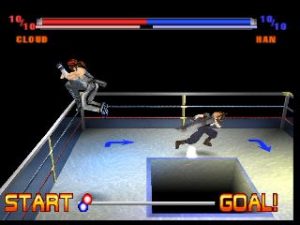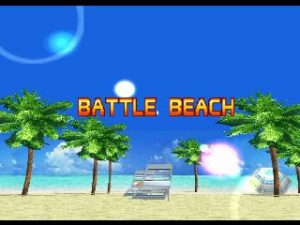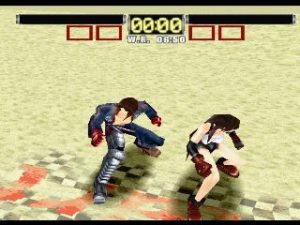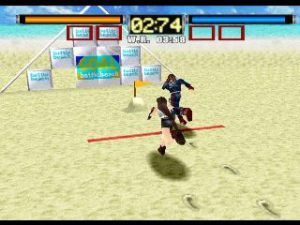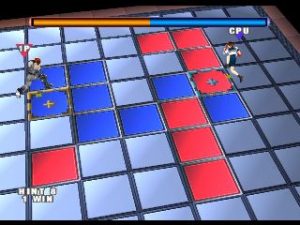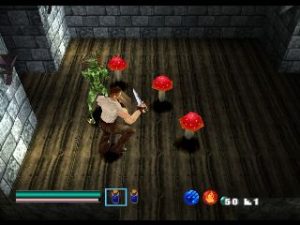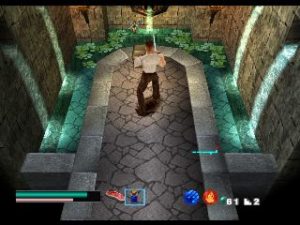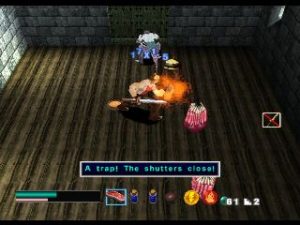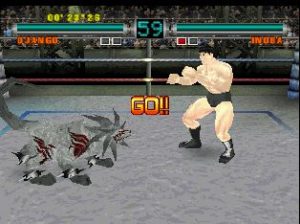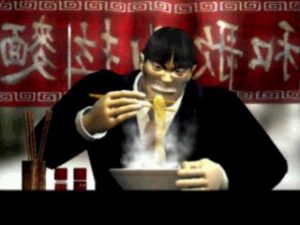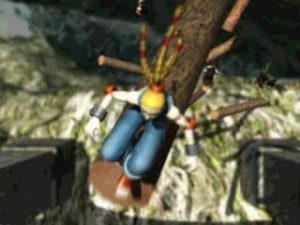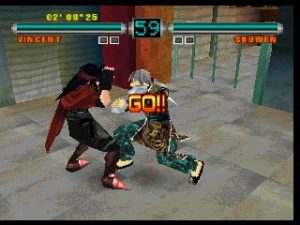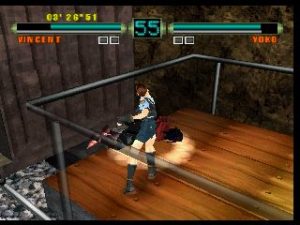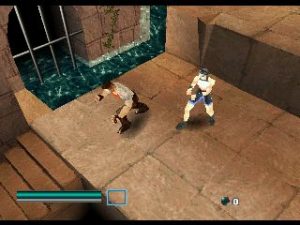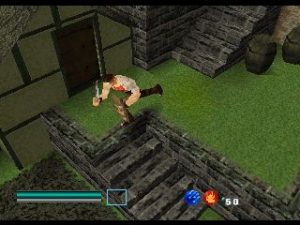Ehrgeiz is a fairly obscure 3D fighting game from the makers of the Tobal games. Created by Dream Factory (a subsidiary of Squaresoft) and brought to the arcades by Namco, Ehrgeiz was a fairly competent fighting game with some unique features that set it apart from the Tekkens and Virtua Fighters of the day.
Rather than build off the proven 2D fighter formula and just add buttons to sidestep as with Tobal, Dream Factory built their control scheme from the wrestling games of the day. This means that full 360-degree motion is possible, and fighters do not necessarily have to face each other all the time.
The Story So Far: There was once a legendary sword known as Ehrgeiz. It remained within an ancient ruin for quite a while, sealed behind a door that could only be opened with the Ehrgeiz stone. This stone remained in the hands of a wealthy man and was eventually put up as the prize for a fighting tournament. The man that wins the stone can open the door and obtain the legendary sword. So naturally, a whole bunch of people sign on for the tournament. Some of the rendered characters are… really, really ugly. The drawn artwork of some of them isn’t so bad, but they make the CGI cutscenes look pretty unappealing.
Characters
Ken “Godhand” Mishima
Probably not related to Tekken‘s Heihachi Mishima, Ken was once a mercenary working for Red Scorpion. He resigned, however, which meant that he’d have to sacrifice his right hand. After resigning, though, he sold out the Red Scorpion and discovered the location of the Ehrgeiz stone. He arranged to have a prosthetic hand attached so that he could fight again, and entered the tournament so that he could get his hands on this weapon himself. Godhand’s hand can detach to reveal a hidden mini-rocket launcher, which can shoot a swarm of homing rockets if charged long enough. He can also drop remote-detonated land mines.
“Dasher” Inoba
A Japanese pro wrestler. Has a thing for noodles (as evidenced by his ending video). Being a wrestler, his style mostly involves grabs and submission holds. He usually fights in a pair of shorts, but his alternate costume puts him in a sharp-looking business suit.
“Yo-Yo” Yoko Kishibojin
A female ICPO officer that uses a modified yo-yo instead of a sidearm, and she uses said yo-yo in quite a deadly fashion. She’s the daughter of Koji Masuda (the male lead for the quest mode). She has probably the silliest ending video of anybody in the game (next to Inoba’s), and her AI player tends to abuse her special moves and interrupts.
Han Daehan
A rising young Korean action star that lost his leg mysteriously. Like Godhand, he had it replaced with a rocket launcher, and when it’s out of ammo, he can slap people silly with his foot. He wants to obtain Ehrgeiz so he can get his real leg back. He also owns a cat. Han is an oddity in the game, in that he is the only character that has two endings (depending on whether or not you manage to kill the “final” final boss in the credits sequence).
Prince Doza
Known as Prince Naseem in the Japanese version, Doza is your typical kickboxer that is looking for a better opponent. He has very little interest in obtaining Ehrgeiz and just wants to get a good fight. He can shoot fireballs from his fists, as well, putting him even closer to being another Sagat clone.
Lee Shuwen
A Kempo master capable of killing a man with a single blow. He was apparently killed years ago, but drank an elixir that somehow resurrected him. He ages in reverse, which is obviously a bad thing, as he will die (again) if he gets too young. So, naturally, he goes in search of Ehrgeiz to see if that will fix him. Shuwen carries a nasty extendable spear that can be used almost all the way across a stage, and he actually does have the ability to kill a guy with a single shot (though said ability is incredibly easy to avoid, because he turns bright red and paces around for five seconds before he attacks).
Sasuke
A ninja, presumably working with Red Scorpion, except he has amnesia (gee, how original). He believes that obtaining Ehrgeiz will lead him to his quarry, the archaeologist Koji Masuda. As expected, he carries a sword and throwing stars.
Wolf Girl Jo
As a child, “Jo” was the sole survivor of a deadly plane crash in the Amazon. She was raised by wolves and eventually captured, and then recruited by Red Scorpion. Her orders? Get Ehrgeiz. Of course. She doesn’t have any projectile attacks (unlike half the other characters) but she’s really fast and can actually transform into a wolf.
Koji Masuda
The archaeologist that supposedly found Ehrgeiz in the Middle East, who is also conveniently a 3-time champion of the Ehrgeiz Championship Tournament. His main starring role is in the Quest Mode. Also has a job as a professor at some university. He’s one of the secret characters in the main game. When fully charged, Koji’s special attack is downright brutal, snapping every bone in the opponent’s body one by one.
Clair Andrews
Koji’s star student, who enrolled in the university at 16. Looks suspiciously like Fio from the Metal Slug games. Not only is she a genius, she’s also a really good fighter (and she’s also better at using magic than Koji is, in the quest mode anyway). She’s another secret character in the main game.
Django
The “final” boss, who is relatively annoying to fight, considering he’s a quadraped and stands half as tall as most fighters (which leads to severe Choi Bounge syndrome, since a majority of the melee attacks in Ehrgeiz are aimed at the upper body). Also has really annoying homing fireballs. Eventually you can play as Django in the main game, and harness these annoying attacks yourself.
The PlayStation version of the game also has six cameo characters from Final Fantasy VII. Cloud, Tifa, and Sephiroth are all available from the get-go, with Yuffie, Vincent, and Zack that can be unlocked later on. You might also notice that Django looks oddly like Red XIII – as a matter of fact, that’s Django’s alternate costume. As a result, Ehrgeiz became known as the “Final Fantasy fighting game”, even though the characters were just added to lure RPG fanboys in.
Ehrgeiz‘s fighting system consists mostly of close combat attacks that can be aimed at the upper or lower body. There are various combos that can be initiated, Tekken style, with no real super-moves to be seen. Though in addition to regular attacks, characters also have three major Special attacks that can be used by pressing the Circle button. Usually it’s fireballs of some type, though some characters can transform, charge into the opponent, or use a super-powerful melee attack. Using a special attack drains the special meter. Most characters can use a more powerful special by holding Circle for a while, and the final special attack can only be used when the special gauge is completely empty.
Getting around the ring is pretty easy. There is no need to double-tap dash, as your character always breaks into a hard dash whenever you push a direction (though you can walk by holding the block button). There are also platforms around the arena that you can jump on to, which don’t serve so much purpose other than to get a good vantage point to lob projectiles (or body-slam the opponent from above). Thankfully, there are no ring-outs, though some matches can boil down to chasing each other in circles if both of you have wasted your special gauges and can’t use projectiles.
There are a few other interesting mechanics: characters will glow different colors depending on what happens. For example, you’ll be bright blue if your back is to the opponent (and you can’t block if you’re not facing them). Characters also glow bright red when an attack cannot be blocked (usually the case with the specials, like Cloud’s buster sword). The PlayStation version has an option that places crates in the levels that you can shove at each other, and when they break, they eject little coins and throwable weapons that you can pick up and throw at each other (and sometimes they stick in your opponent until the end of the round). The one issue there is that it’s hard to actually use the crates, since the same button combination used to grab your opponent (Block+High+Low) is also used on crates, which means that sometimes your character will just sit there and make grabbing motions instead of pushing the damn crate.
The truly major problem with Ehrgeiz‘s battle system is that it seems to reward button mashing over actual strategy. Outside of the manual, there is little reference to how to perform the trickier combos (like Shuwen’s deathblow), so experimentation is really the best way to figure out good combos to use. The emphasis on projectile attacks will also make the fights seem more like Street Fighter II-style turtling matches (since fireballs will explode on contact with each other).
Ehrgeiz was ported to the PlayStation about a year after it hit arcades, and surprisingly, it looks every bit as sharp and smooth as the arcade version, since it runs in high-resolution mode at a perfect 60 frames per second. In addition to the Final Fantasy VII characters playable in the main game, there were also a few minigames added, as well as Brand New Quest: The Forsaken Dungeon.
Battle Beach is a track-and-field game. Basically, you go through three events that determine just how much abuse one person can put on their X button. There’s little strategy to it and it’s really just there. Though if you ever wanted to see what it’d be like if Tifa Lockheart were in Dead or Alive Xtreme Beach Volleyball …
Battle Racer is an odd one – it’s a racing game that uses the regular fighting controls. The gist of it is that you and your opponent run around the track as fast as possible, perhaps stopping to bash your opponent and kick them over the edge (though this slows you down, so most players would probably end up just racing and getting it over with). The perk of this, though, is that the more times you bash your opponent in the face, the faster you can run afterwards. It’s a little confusing sometimes (like when you pick up a Track Reverse powerup, the directional arrows don’t change, and you can actually lose your race progress by going backwards.)
Battle Panel is probably the strangest. If you’re familiar with the classic board game Reversi / Othello, this is mostly what Battle Panel is about – except it’s in complete real-time, and you can tackle your opponent. It’s as if Technos made a Kunio-themed board game – traditional board game mechanics, with a nice healthy dose of violence added in for good measure. Don’t want Godhand to take that winning panel? Bash him away from it!
Lastly, the final mode (Infinity Battle) is really just a glorified Survival mode, though you have limited lives to fight with (and you can earn more by doing well in the fights).
Quest Mode is probably the biggest draw – essentially, it’s an expansion of the Quest Mode found in Tobal 2, which never made it to the States. Since DreamFactory is part of Squaresoft, they really know what they’re doing. You play as both Koji and Clair, as you investigate the legendary Forsaken Dungeon in search of a priceless artifact (namely, Ehrgeiz). The quest feels a lot like Diablo – there’s a little town that you can shop in, repair stuff, and ask for advice. The dungeon is several levels long, and they’re randomized each time, so if you’re passionate about your dungeon crawling, this isn’t a bad way to get your fix.
Weapons are your typical affair (aside from the inclusion of gloves which enable you to use martial arts moves), but the notable addition is Protection. What this means is that, out of the various weapons and armor you’ll find in the dungeon, some of them will be protected by a god, adding or removing various attributes to you when they’re equipped. If you can find a protected item, you can have the blacksmith in town move the protection onto another weapon (but only if you give him a drink first). This way, you can move all sorts of protections onto one weapon and have a really awesome sword or armor in the end.
You actually play as both characters in quest mode, but you can only use one at a time. The one you don’t play as will wait for you in the hotel. If you die in the dungeon, the game automatically switches to the other character. You have to find where you died at, and pick up the backpack that contains the spirit of the dead character, at which point you can play as them again. It’s a neat mechanic, but sometimes this is quite hard to do (though you can try and make it somewhat easier by buying extra weapons and armor and dropping them in the hotel room for your partner to use in case you die).
Another complaint with quest mode is the traps. In any given room in the dungeon, there is a chance that there is a pressure plate hidden in the floor that will close all the doors to the room and force you to fight a wave of monsters to open them again. You can’t open them again unless ALL of the monsters are dead – so if you’re about to kill the last one and another bunch spawns in at that moment, you’ll have to kill them too. You can’t heal yourself without potions, and you can’t open the menu in the middle of a battle, so you have to use the Satchel (four quick-slots that can be modified as you please) to store what you think you’ll need. Once the Satchel is emptied, you’re out of luck.
Lastly, the most ridiculous mechanic to be found in the game is the fact that it costs money to save your game. It starts out that you only need 20 gil to save, but as you increase in levels, the price skyrockets until it comes somewhere in the area of 500 gil. JUST TO SAVE THE DAMN GAME. Not only is that needlessly limiting, it also makes it hard to quit in the middle of the game unless you’ve found enough loot to pay off your save fee.
The graphics of Ehrgeiz are pretty slick for a PlayStation game. Considering that the prettiest game of the time was Syphon Filter (which had relatively chunky graphics and a low framerate), Ehrgeiz blows just about every other PlayStation game out of the water with some very nice looking character models and very little slowdown (though it can lag a bit in quest mode when there’s a lot of monsters in the room – this rarely happens though). There is one notable flaw, however – special sprite effects are quite blocky (especially in quest mode).
Ehrgeiz‘s audio is fairly good as well – the music is provided by Takayuki Nakamura (Virtua Figher, Tobal 2), with a few pieces and arranged versions by Nobuo Uematsu. Character voices don’t get annoying that fast, with some exceptions (Clair). The music in quest mode can get a little repetitive after a while, but it does change tracks every three floors, so it’s not that bad.
On the whole, Ehrgeiz is a pretty good investment – it’s not that hard to come by at all (a quick search on eBay lists $30 at the very most), however the game didn’t make the Greatest Hits collection and was never re-released, so your chances of finding it at a used game store are rather slim. Generally, though, it’s at least somewhat worth the effort – if not quite as good as other games like Tekken or Diablo, it does a fairly good job of doing both ends of the game (fighting and RPG) and succeeds in making it look quite good to boot. Add to that, Final Fantasy fanboys are bound to love the game just for the inclusion of Cloud and company (though it would have been really cool to play as Aeris and beat people silly with her staff).
